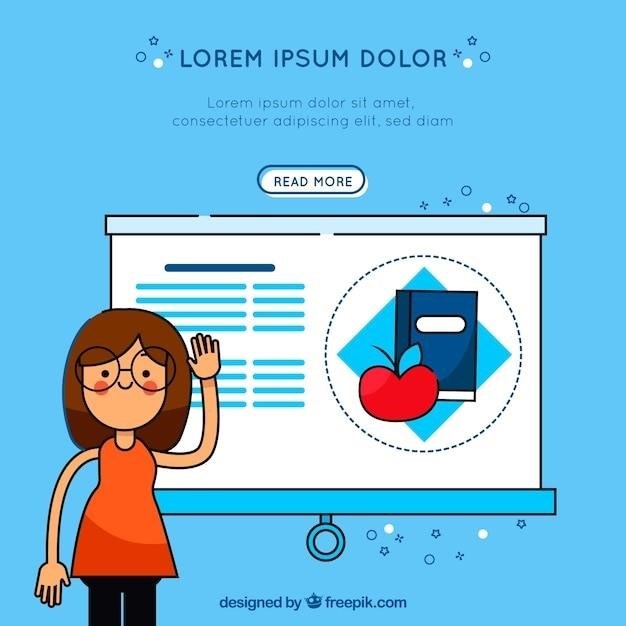What is an AVID Tutorial Request Form (TRF)?
The AVID Tutorial Request Form (TRF) is a crucial tool used by AVID students to seek additional academic support from their peers and tutors. It acts as a guide for both the student requesting help and the tutor providing it‚ outlining the specific area of confusion‚ resources used‚ and the collaborative inquiry process.
A Guide to Using the TRF in AVID
The AVID Tutorial Request Form (TRF) is a structured document designed to facilitate a focused and productive tutoring experience. It serves as a roadmap for both the student seeking assistance and the tutor offering support. The TRF guides students through a systematic process‚ ensuring that they actively participate in their learning and take ownership of their academic growth. The form encourages students to articulate their “Point of Confusion” (POC) clearly‚ identify relevant resources‚ and engage in collaborative inquiry with their tutor. By completing the TRF‚ students demonstrate their commitment to seeking help‚ fostering a culture of support and accountability within the AVID program.
Purpose of the TRF
The AVID Tutorial Request Form (TRF) serves a multifaceted purpose within the AVID program. Primarily‚ it acts as a bridge between students seeking academic assistance and their peers or tutors who provide support. By outlining the specific area of confusion‚ the TRF allows students to articulate their learning needs clearly‚ fostering effective communication and targeted support. It also guides students through a structured process of self-reflection and resource utilization‚ encouraging them to take ownership of their learning and develop independent study skills. Moreover‚ the TRF serves as a valuable tool for assessing student progress and identifying areas where additional support may be needed.
Components of a TRF
An AVID Tutorial Request Form (TRF) typically consists of several key components designed to facilitate a structured and effective tutorial process. These components include sections for the student’s name‚ date‚ AVID period‚ and subject. A crucial element is the “Point of Confusion” (POC) section‚ where students articulate the specific concept or problem they’re struggling with. The TRF also includes sections for pre-work inquiry‚ where students demonstrate their initial understanding and identify relevant resources‚ and collaborative inquiry‚ where they document the questions asked and answers provided during the tutorial session. Finally‚ the TRF often includes sections for communication‚ reflecting on the effectiveness of the tutorial‚ and closure‚ summarizing the key takeaways and any remaining questions.
Pre-Work Inquiry
The Pre-Work Inquiry section of the AVID TRF is designed to encourage students to actively engage with their learning before seeking help. Students are expected to demonstrate their initial understanding of the concept or problem by writing down what they already know‚ showing their work or attempts at solving the problem‚ and listing any resources they’ve consulted. This section helps students identify their specific point of confusion and prepares them for a more focused and productive collaborative inquiry session. By completing the Pre-Work Inquiry‚ students take ownership of their learning and develop essential self-directed learning skills.
Collaborative Inquiry
The Collaborative Inquiry section of the AVID TRF is where the heart of the tutorial process takes place. Students‚ guided by their tutors‚ engage in a structured dialogue using Socratic questioning techniques. This means asking open-ended questions to encourage critical thinking and problem-solving. The tutor doesn’t simply provide answers; they act as facilitators‚ helping students explore their point of confusion and arrive at a deeper understanding through guided inquiry. This collaborative process fosters peer learning‚ active participation‚ and a deeper understanding of the subject matter. The TRF serves as a framework for this inquiry‚ ensuring that both the student and the tutor are focused on the specific learning goals.
Communication
Effective communication is essential for a successful AVID tutorial. The TRF encourages clear and concise communication between the student and the tutor. Students are encouraged to articulate their point of confusion clearly and concisely‚ providing specific details about what they don’t understand. Tutors‚ in turn‚ use clear language and appropriate questioning techniques to guide the student’s understanding. The TRF also serves as a record of the communication that took place during the tutorial‚ providing a valuable reference point for both the student and the tutor. This focus on communication ensures that the tutorial is a productive and beneficial learning experience for all involved.
Closure
The closure section of the TRF represents a crucial step in the tutorial process. This section provides an opportunity for both the student and the tutor to reflect on the learning experience. Students are encouraged to summarize what they learned during the tutorial and identify any remaining areas of confusion. Tutors can offer additional support or guidance based on the student’s reflection. The closure section also allows for the evaluation of the effectiveness of the tutorial‚ ensuring that it met the student’s needs and contributed to their understanding. This reflective process helps to solidify the learning that took place and prepares the student for future academic challenges.
Benefits of Using a TRF
The AVID Tutorial Request Form (TRF) offers numerous benefits for both students and tutors. For students‚ the TRF provides a structured framework for seeking support and clarifying areas of confusion. It encourages them to engage in self-reflection and identify specific learning needs‚ fostering a sense of ownership over their academic progress. For tutors‚ the TRF serves as a guide‚ providing valuable insights into the student’s learning process and facilitating effective and targeted support. The TRF also promotes collaboration and communication between students and tutors‚ creating a supportive and enriching learning environment. Ultimately‚ the TRF empowers students to become active participants in their learning journey‚ maximizing their academic potential through collaborative learning and effective support.
Tips for Completing a TRF
To maximize the effectiveness of your AVID Tutorial Request Form (TRF)‚ consider these helpful tips⁚
- Be specific⁚ Clearly articulate your Point of Confusion (POC). Avoid vague questions and provide specific details about what you don’t understand.
- Pre-work⁚ Before the tutorial‚ engage in pre-work activities‚ such as reviewing notes or attempting practice problems‚ to demonstrate your effort and identify specific areas where you need further guidance.
- Resourceful⁚ Utilize your available resources‚ such as textbooks‚ notes‚ and online materials‚ to actively seek answers before requesting tutorial support.
- Focused notes⁚ During the tutorial‚ take focused notes‚ using the three-column note-taking method to organize information effectively and enhance your understanding.
- Reflect⁚ After the tutorial‚ reflect on your learning experience. Did you gain a clearer understanding? What strategies did you find most helpful? This reflection will guide your future learning.
- Collaboration⁚ Actively participate in the collaborative inquiry process‚ asking questions and engaging with your tutor and fellow students to deepen your understanding of the topic.
Examples of TRF Questions
To illustrate the types of questions suitable for an AVID TRF‚ consider these examples⁚
- Math⁚ “I’m having trouble understanding how to solve for x in quadratic equations. I’ve tried the examples in the textbook‚ but I’m still confused about factoring.”
- Science⁚ “I’m struggling to differentiate between mitosis and meiosis. I’ve read the chapter‚ but I’m still unclear about the key differences in the processes.”
- History⁚ “I’m confused about the causes of the French Revolution. I’ve read about the social‚ economic‚ and political factors‚ but I’m struggling to connect them to the overall event.”
- English⁚ “I’m unsure how to write a persuasive essay about the importance of environmental protection. I’ve brainstormed ideas‚ but I’m struggling to organize my thoughts into a strong argument.”
These examples demonstrate the specificity and clarity required in a TRF question‚ enabling tutors to provide targeted support and facilitate effective learning.

The Role of Tutorials in AVID
AVID tutorials are a cornerstone of the program‚ providing a collaborative learning environment where students can address their academic challenges and develop essential skills.
The AVID Tutorial Process
The AVID tutorial process is a structured approach to providing academic support and fostering student collaboration. It begins with the student completing a Tutorial Request Form (TRF) to articulate their point of confusion and identify the specific topic they need help with. This pre-work step is essential as it encourages students to engage with the material before seeking assistance. The TRF serves as a roadmap for the tutorial session‚ guiding the collaborative inquiry process.
During the tutorial‚ students work together in small groups‚ led by a trained AVID tutor. The tutor facilitates a discussion using Socratic questioning‚ encouraging students to explore their understanding‚ identify gaps in their knowledge‚ and arrive at a solution through critical thinking and problem-solving. The tutorial environment encourages peer learning‚ as students learn from each other’s perspectives and approaches.
Throughout the process‚ students are expected to take focused notes‚ utilize resources‚ and actively participate in the discussion. The tutor provides guidance and support but avoids simply giving answers. Instead‚ they encourage students to take ownership of their learning and develop their problem-solving abilities. The tutorial concludes with a reflection phase‚ where students summarize their understanding and identify areas for further study.
The Importance of Tutorials in AVID
AVID tutorials play a vital role in fostering academic success and promoting student growth. They provide a structured environment for students to address their academic needs‚ develop critical thinking skills‚ and build confidence in their abilities. The tutorial process encourages active learning‚ collaboration‚ and self-discovery‚ empowering students to take ownership of their learning journey.
Tutorials offer a safe space for students to ask questions‚ explore concepts‚ and receive support from their peers and tutors. They provide an opportunity to solidify understanding‚ clarify misconceptions‚ and develop deeper comprehension of challenging topics. The collaborative nature of tutorials fosters a sense of community and shared learning‚ encouraging students to support and learn from each other.
The use of the Tutorial Request Form (TRF) further emphasizes the importance of active engagement and self-reflection. By completing the TRF‚ students are actively involved in identifying their learning needs and setting the stage for a productive tutorial session. This process not only enhances their understanding but also promotes a sense of responsibility and self-advocacy.
Benefits of Participating in Tutorials
Participating in AVID tutorials offers a multitude of benefits for students‚ contributing to both their academic and personal growth. The collaborative nature of tutorials fosters a supportive and inclusive learning environment‚ where students feel comfortable asking questions and seeking clarification without fear of judgment. This encourages active participation and engagement‚ fostering a deeper understanding of concepts and promoting critical thinking skills.
Tutorials provide a structured platform for students to practice effective communication and problem-solving strategies. They learn to articulate their thoughts clearly‚ collaborate effectively with their peers‚ and develop their analytical and reasoning abilities. The process of working through challenges together builds confidence and resilience‚ empowering students to approach academic tasks with a sense of ownership and determination.
Moreover‚ the use of the Tutorial Request Form (TRF) encourages students to take responsibility for their learning and actively participate in the tutorial process. It promotes self-awareness and reflection‚ enabling students to identify their specific needs and areas for improvement. By actively seeking support and engaging in meaningful discussions‚ students develop a deeper understanding of the material and gain valuable insights that contribute to their overall academic success.

Resources for AVID Students
AVID offers a variety of resources to support student success‚ including a comprehensive tutorial guide‚ online platforms‚ and dedicated contact information for assistance.
AVID Tutorial Guide
The AVID Tutorial Guide is a valuable resource for both students and teachers‚ providing a comprehensive overview of the AVID tutorial process. This document outlines the steps involved in completing a TRF‚ from identifying points of confusion to collaborating with tutors and reflecting on the learning experience. It also includes sections on pre-work‚ collaborative inquiry‚ communication‚ closure‚ and critical thinking‚ offering guidance on how to effectively engage in tutorials and maximize their benefits. The guide serves as a roadmap for students to navigate the tutorial process with confidence and achieve academic success.
Online Resources for AVID Students
The digital age offers a wealth of resources for AVID students seeking additional support and guidance. Online platforms provide access to a vast array of materials‚ including tutorial guides‚ videos‚ and practice exercises that can enhance understanding and reinforce learning. Websites dedicated to AVID offer comprehensive information on the program‚ its objectives‚ and the importance of tutorials. These resources serve as valuable supplements to in-class learning‚ providing students with the flexibility to access information at their own pace and explore specific topics in greater depth. By leveraging these online tools‚ AVID students can unlock a world of knowledge and expand their academic horizons.
Contact Information for AVID Support
For students and educators seeking assistance with the AVID Tutorial Request Form (TRF) or any other aspect of the AVID program‚ dedicated support channels are available. AVID organizations and institutions often maintain websites with comprehensive contact information‚ including email addresses‚ phone numbers‚ and physical addresses. These resources allow individuals to connect with trained professionals who can address inquiries‚ provide guidance‚ and offer solutions to challenges encountered during the TRF process. By reaching out to these support systems‚ students and educators can ensure a smooth and effective implementation of the AVID program‚ maximizing its potential to foster academic growth and success.



